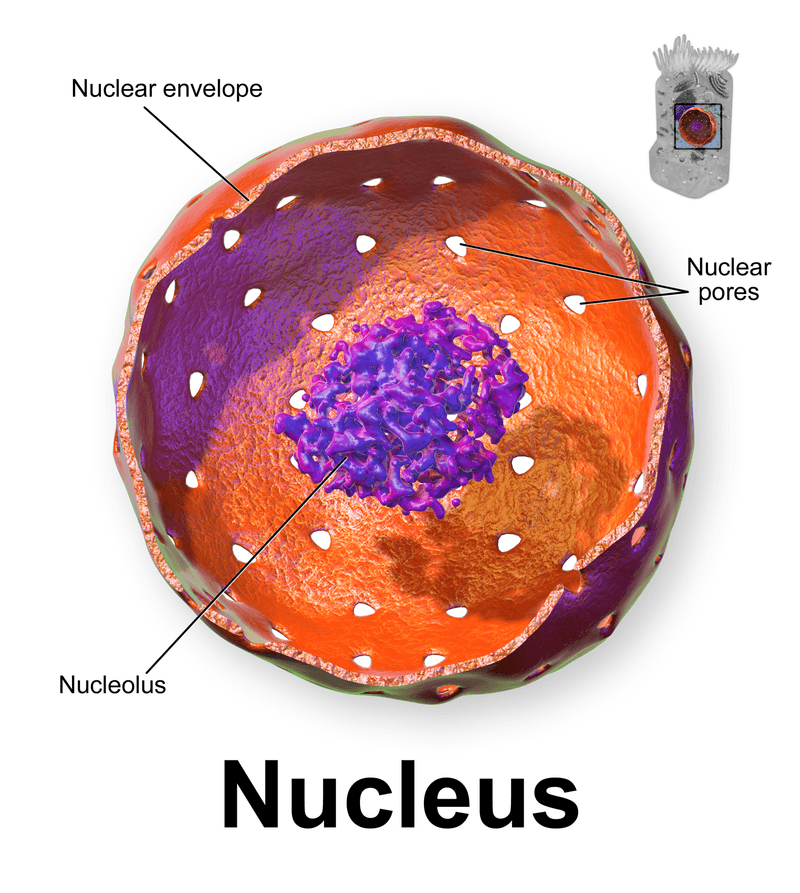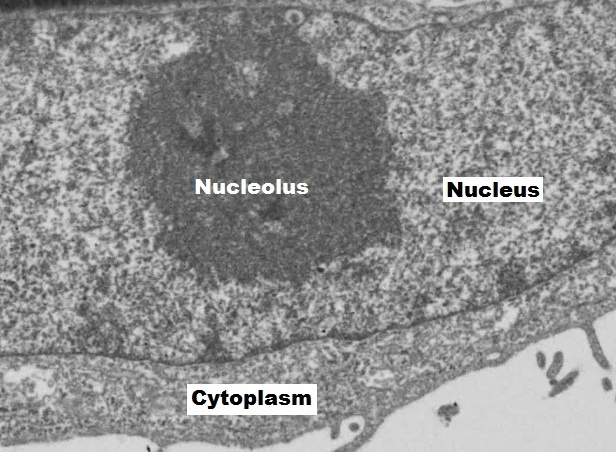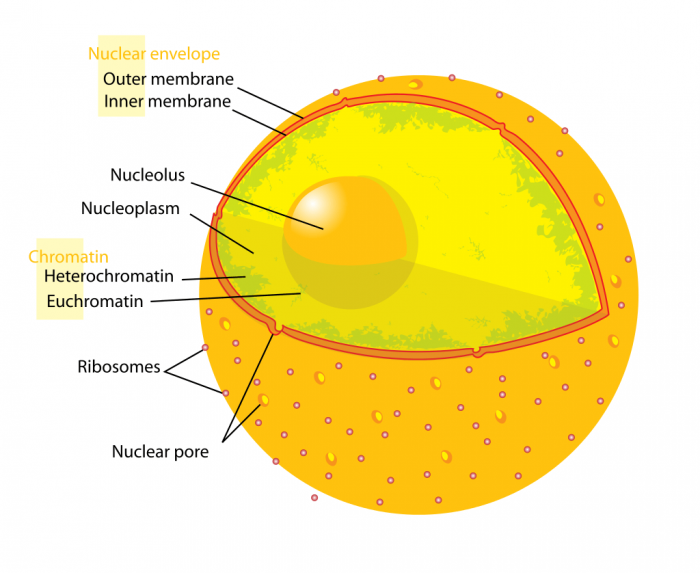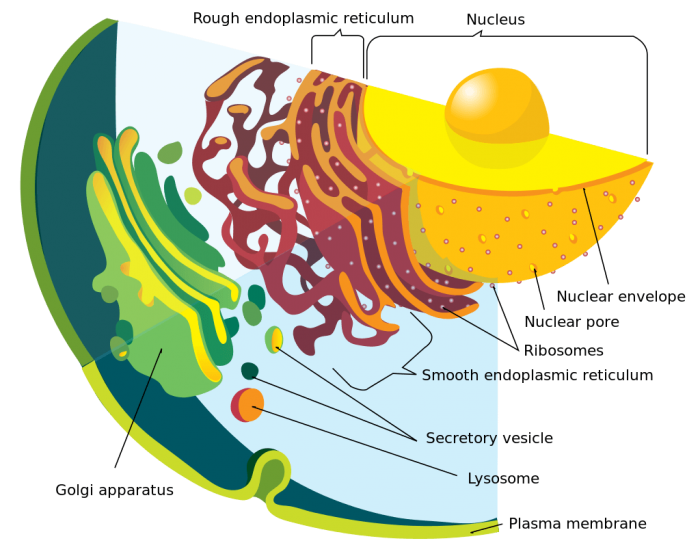
The nucleolus is a smaller organelle found within the nucleus of eukaryotic cells. The nucleolus is comprised of collections of DNA, RNA, and various proteins. The components that make up the nucleolus are gathered around areas known as nucleolus or organizing regions. The nucleolus doesn’t just organize RNA and DNA, it also serves as the site of creation for ribosomes.
A Closer Look At The Nucleolus

Photo: By Orlov I, Schertel A, Zuber G, Klaholz B, Drillien R, Weiss E, Schultz P, Spehner D – part of still frame of File:Live-cell-immunogold-labelling-of-RNA-polymerase-II-srep08324-s2.ogv at https://commons.wikimedia.org/wiki/File:Live-cell-immunogold-labelling-of-RNA-polymerase-II-srep08324-s2.ogv editing by JeanOhm (talk) 19:11, 23 June 2017 (UTC), CC BY-SA 4.0, https://commons.wikimedia.org/w/index.php?curid=60325020
Within biology, the two major types of cells are eukaryotic cells and prokaryotic cells. The differences between the two kinds of cells are notable enough to merit their own article, but one of the major differences is that prokaryotic cells don’t have a nucleolus, only eukaryotic cells have a nucleolus. In fact, only eukaryotic cells have a nucleus at all. The nucleus is often referred to as the brain of the cell, and it is a membrane-bound structure that contains the genetic/hereditary information of the cell and controls the growth and reproduction of the cell.
All eukaryotic cells have a nucleus, which means that both plant cells and animal cells have a nucleus and nucleolus. The nucleolus is a smaller organelle or sub organelle of the nucleus. The nucleolus is a small round structure which is composed of DNA protein and RNA. The nucleolus is involved in the production of ribosomes, and it is also involved in the creation of ribosomal RNA. The plural of nucleolus is nucleoli, and nucleoli can vary in number within a cell, with a cell having only one or many nucleoli. Nucleoli form around areas referred to as nucleolus organizer regions, which is part of the chromosomes of the cell. The region that holds the nucleolus picks up the nucleolus right after the nucleus divides within the cell. The nucleus actually has several other structures present within it, with the nucleolus being just one of them.
The ribosomal RNA is synthesized within the nucleolus, and processed with the assistance of ribosomal proteins. For this reason, the nucleolus is frequently referred to as the ribosome factory. The nucleolus itself can be divided into three different parts. The first portion of the nucleolus is known as the dense fibrillar component, while the second portion of the nucleolus is the fibrillar center. Finally, the third portion of the nucleolus is referred to as the granular components.
It is suspected that the multilayered nature of the nucleolus is a result of an evolutionary process which lead to anamniotes becomes amniotes. The intergenic region of the DNA became more complex, and because of this the original fibrillar component was divided into different regions which constitute the fibrillar centers and the dense fibrillar components.
Function Of The Nucleolus
The main function of the nucleolus is to help regulate cellular functions and to control the transactions of proteins within the cell. The nucleolus is not membrane-bound, which assists it in holding ribosomes that themselves hold ribonucleic acid. For this reason, another primary function of the nucleolus is to assist in the production of ribosomes, assembling them from constituent molecules. The nucleolus also serves as a point of suspension for smaller organelles within the nucleus of the cell.
The nucleolus has abundant amounts of RNA within it, and the large number of molecules in it helps the nucleus maintain its shape and structure. The nucleolus has other functions as well, such as assisting in the transportation of ions and molecules that the cell needs, like substances necessary for cell metabolism.
Between the interior parts of the nucleolus and the nucleoplasm, there is an uninterrupted transport chain which runs through a long system of nuclear passages. These passages let macromolecules move throughout the nucleolus. Because the nucleolus is involved in the production of ribosomes and has a close relationship with the chromosomal matter in the cell, the malfunctioning of the nucleolus is suspected to be linked with the development of various diseases and disorders.
Other Parts Of The Nucleus

Photo: By Mariana Ruiz LadyofHats – I did it myself with adobe illustrator using the information found here [1], [2] ,[3], [4] and [5], Public Domain, https://commons.wikimedia.org/w/index.php?curid=736389
The nuclear membrane separates the interior of the nucleus from the cytoplasm and the rest of the organelles in the cell. Pores within the nuclear envelope/nuclear membrane play an important role in the transportation of materials back and forth between the cytoplasm and the nucleus. The nuclear envelope involved with the regulation of nucleocytoplasmic swapping and organizing the gene action activity of the cytoplasm. The nuclear membrane is also sometimes called the karyotheca.
Nuclear Sap
Within the nucleus there is a homogenous matrix that appears during interphase, made out of a semi-solid, a transparent substance referred to as karyolymph or nuclear sap. This fluid has many particles floating around in it, mainly proteinous material, and the nuclear sap is the main area where enzyme activity takes place. During the different stages of cellular division, the nuclear sap takes on a different appearance. ITtis also thought that the spindle apparatus in plants is formed with the assistance of the karyolymph.
Nuclear Constituents
In addition to the nuclear membrane and nuclear sap, the nucleus has DNA, RNA, some organic phosphorous compounds, two different types of proteins, various lipids, and inorganic compounds like salt. The amount of DNA and RNA in the nucleus will vary between the different types of cell. Enzymes in the nucleus include those necessary for anaerobic metabolism and for the creation of high-energy phosphates. The proteins found in the nucleus include structural proteins, nucleoproteins, and enzymes.
Other Parts Of The Cell

Photo: By Mariana Ruiz Villarreal LadyofHats – the diagram i made myself using adobe illustrator. as a source for the information i used the diagrams found here:[1], [2], [3], [4], [5], [6] and [7]., Public Domain, https://commons.wikimedia.org/w/index.php?curid=8152684
Ribosomes can be found in a wide range of cells, and they are in charge of making proteins. This is accomplished by mapping the directions for a particular protein onto messenger RNA, or mRNA. The mRNA is then moved to the ribosome by transfer RNA (tRNA). The data encoded into the RNA is then used to put the amino acids in the correct order/sequence, making the correct protein. Ribosomes can be witnessed moving around in the cytoplasm of a cell or joined to segments of the rough endoplasmic reticulum.
Endoplasmic Reticulum
The endoplasmic reticulum is divided into two different sections – the smooth endoplasmic reticulum and the rough endoplasmic reticulum. The rough endoplasmic reticulum is called “rough” because it is covered in ribosomes, while the smooth endoplasmic reticulum lacks ribosomes. Both versions of the endoplasmic reticulum are comprised of sacs called cisternae, arrayed in a long, winding network. The function of the rough endoplasmic reticulum is to synthesize proteins with the ribosomes that are attached to it, while the role of the smooth ER is to breakdown toxic substances in the cell, rendering these substances inert and harmless.
Mitochondria
The mitochondria are frequently referred to as the “powerhouse of the cell”, as they are responsible for creating the energy that the cell will use for various functions. The mitochondria produce adenosine triphosphate or ATP, which is the type of energy that the cell can use. ATP is created by breaking down sugars and fats, which come into the body through the consumption of food. Sugar and oxygen are converted into ATP through the process of cellular respiration. Cellular respiration is a much more efficient method of producing energy than anaerobic respiration, which is a method of producing energy without oxygen.
Golgi Body
The Golgi body is a structure that is responsible for facilitating the transportation of proteins, putting proteins into vesicles for transportation. The Golgi body is sometimes referred to as the Golgi complex or Golgi apparatus. The Golgi body is responsible for the folding of proteins and the sorting of those proteins, ensuring that the proteins will be sent to the correct destination. For this reason, the Golgi body is sometimes said to be the post office of the cell.
Vesicles
Vesicles are small spheres which transport various materials around the cell, moving proteins and other necessary compounds to one organelle from another organelle. Vesicles can be found in many different sizes and shapes, and there are even vesicles that serve specific, specialized functions. These specialized vesicles are called lysosomes and they are responsible for breaking down word out cell parts, freeing up their constituent parts so that the parts can be used to create new cell parts. Lysosomes also function to break down macromolecules. Because the cell wall found in plant cells keeps out foreign material, plant cells usually lack lysosomes. In addition, vesicles are linked together to create the phospholipid bilayer that envelops the cell.
Cell Membrane
The cellular membrane, sometimes called the plasma membrane, is the structure responsible for separating the cell’s interior from the outside world. The major function of the plasma membrane is to protect the organelles of the cell from harmful molecules in the surrounding area. The cell membrane is said to be “selectively permeable” meaning that certain substances can pass through while others can’t. The cell membrane is constructed out of a phospholipid bilayer, with phospholipids having two parts – a water avoiding/repelling tail and a water-loving/accepting head. The phospholipids join together in a layer that faces the opposite direction of another phospholipid layer, with the result that the outsides of both layers are hydrophilic/water-loving and the inside area is hydrophobic/water-avoiding. This bilayer has small pores in it that let approved substances move back and forth through it while keeping harmful substances out.









